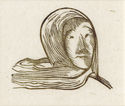
19th, 20th & 21st Century Fine Prints
707-546-7352 · fax 707-546-7924 · web: www.annexgalleries.com · email: artannex@aol.com
Edward Gordon Craig Biography
Edward Gordon Craig
British
1872–1966
Biography
Edward Gordon Craig was born in Stevenage/Hertford, England on January 29, 1872, the son of the actress Ellen Terry and the architect, stage designer and theatre director Edward William Godwin. Between 1889 and 1897 he worked as an actor at Henry Irving's "Lyceum Theatre" in London and began to design his own figurines and stage designs. Craig was increasingly interested in graphics and was taught woodcut techniques by James Pryde, William Nicholson and William Rothenstein around 1893. Edward Gordon Craig executed uncounted exlibris, portraits of actors, theatre brochures and book illustrations. In his journal "The page" he published several graphics using various pseudonyms.
In 1899 Craig turned back to the theatre and founded the "Purcell Operatic Society" together with the composer Martin Fallas Shaw. Here his most important theatre works were executed. With the help of Harry Graf Kessler in Weimar he got acquainted with important contemporary artists and achieved an international breakthrough with his programmatic essay "The Art of the Theatre".
Edward Gordon Craig became the reformer of the stage design which had been dominated by the aesthetic of depiction and illusionism. During his lifetime he was barely able to realise his radically new theatre concept and his abstract stage aesthetic, basing on light and shadow, but his journalistic influence still lasted in the 20th century. Craig had numerous children, 4 with his wife, May Gibson, 2 with his lover Elena Meo and with his lover, dancer Isadora Duncan, had a daughter, Deidre, who drowned at age 7 in 1913.
In 1926 the artist was honoured with the "Order of Knights of Danneborg" for the performance of Ibsen's "Kronprätendenten". Edward Gordon Craig lived in Vence/Alpes Maritimes since 1948, where he attended to scientific studies, drawing, writing, collecting and designing of book covers.
Edward Gordon Craig died in Vence, France on July 29, 1966.








